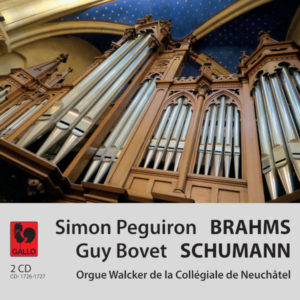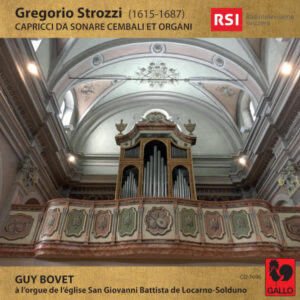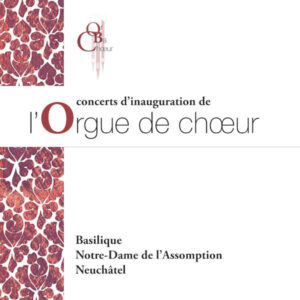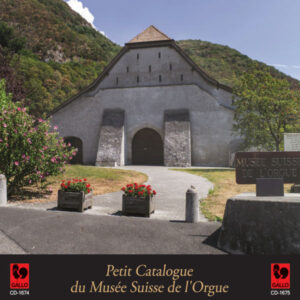Extraits / Excerpts
Mendelssohn: Prelude and Fugue in C Minor, Op. 37 - Organ Sonata No. 6, Op. 65 - Balbastre: Première suite de Noël - Guy Bovet
Felix MENDELSSOHN Prelude and Fugue in C Minor, Op. 37, No. 1, MWV W21 : I. Prelude – Prelude and Fugue in C Minor, Op. 37, No. 1, MWV W18: II. Fugue – Organ Sonata in D Minor, Op. 65, No. 6, MWV W61: I. Choral et Variations – II. Fugue – III. Final (Andante) – Claude BALBASTRE: Première Suite de Noëls: I. Prélude – II. À la venue de Noël – III. Joseph est bien marié – IV. Où s’en vont ces gais bergers – V. Ah ma voisine es-tu fâchée? – VI. Tous les bourgeois de Châtres – VII. Quand Jésus naquit à Noël.
Guy Bovet at the Organs of Saint-Pierre-aux-Liens in Bulle. https://www.guybovet.org/
The Bulle Organ
This instrument was constructed in 1814 by Aloys Mooser, organ builder, and the celebrated instrument made for the Fribourg Cathedral was also his work. This organ was transformed on several occasions, once before 1872 when some additions were made, while conserving the essential structure of the instrument. In 1932, a complete alteration took place: the organ was entirely modified, with three keyboards and a “Récit romantique.” Further changes occurred in 1946-48 in the same spirit.
However, a significant number of original pipes, made by Mooser, survived these successive changes. These pipes belong to the following stops:
- Grand Orgue (GO): Montre 16, Montre 8, Flute 8, Gemshorn 8, Prestant 4, Cornet.
- Positif: Bourdon 8, Montre 4, Flute 4, Flute 2, Tierce (?).
- Récit: Conical Flute 4 (?).
- Pedal: Soubasse and Flute.
The presence of these numerous pipes (480 in total) called for a comprehensive study, made in view of the restoration of 1976, in order to restore the original arrangement of Mooser. This study was based on existing documents in the parish archives and on Mooser’s other organs, more or less well known and conserved (Montorge, Riedisheim, Hauterive, Estavayer-le-Lac, and Saint-Esprit at Berne).
For more detailed documentation on this instrument and its restoration, reference should be made to the article by François Seydoux, “Les orgues de Saint-Pierre-aux-Liens at Bulle,” obtainable on application in writing to the Parish.
The restoration was carried out by Messrs. Füglister in Grimisuat, Valais, with the expertise entrusted to Professor L.-F. Tagliavini of the Institute of Musicology at Fribourg University. The composition, restored, was brought back to that of Mooser, and now consists of the following stops:
| GO (Grand Orgue) – 1er Clavier | Positif – 2e Clavier | Pédale |
|---|---|---|
| Montre 16 (depuis do³) | Bourdon 8 | Soubasse 16 |
| Bourdon 16 | Suavial 8 (depuis do³) | Flûte 8 |
| Montre 8 | Prestant 4 | Prestant 4 |
| Bourdon 8 | Flûte 4 | Bombarde 16 |
| Violflûte 8 | Flûte douce 4 | Bombarde 8 |
| Prestant 4 | Flageolet 2 | |
| Flûte 4 | Cromorne 8 | |
| Quinte 2 2/3 | ||
| Doublette 2 | ||
| Fourniture 4 rangs | ||
| Cornet 5 rangs (depuis do³) | ||
| Trompette |
Choice of Repertoire
Swiss, and even Fribourgeois throughout, with all the characteristics of this bilingual canton, the Bulle organ speaks French and German equally well. It speaks neither of them perfectly (like its constructor, whose literary qualifications are a nice mess of French and German vocabularies and syntaxes), but it manages sufficiently to make its way successfully.
We have chosen to record some works of Mendelssohn on one side, as the great composer played it in 1822, with pleasure, as evidenced by a letter he sent from Geneva to his master Zelter in Berlin. Mendelssohn’s only regret was that the pedal had neither B nor C in the second octave, so that it was ‘impossible to play anything of Bach’. During the restoration, the organ specialist made a little compromise and added these two notes, thereby posthumously fulfilling Mendelssohn’s wish.
The Mendelssohn Prelude and Fugue in C minor is one of the most beautiful pieces in the organ repertoire. It begins with verve and majesty. One senses Bach’s influence throughout the piece, and moreover, what is more remarkable, in the Fugue, the melody flows continuously. Thus, it transforms what could have been an arid exercise in counterpoint or a sterile imitation of a style that became out-of-date towards 1830 into a sort of ‘song without words,’ whose counterpoint, however well-written, is merely the foundation. The theme of the Fugue itself also possesses considerable verve in an elegantly balanced 12/8 rhythm.
The Sonata on the choral ‘Vater unser’ is also a piece much appreciated by organists, especially its Variations. After an exposition of the choral, the first variation introduces the theme in the Soprano over a quiet semi-quaver accompaniment. The second variation, more animated, presents a figure of pedal triplets. The theme then passes to the tenor, culminating in a sort of Toccata, first with the Pedal theme and then moving on to the other voices.
A brief citation of the first and last lines of the choral altogether concludes the movement, which is extremely brilliant and somewhat relegates the two other movements to the background. The Fugue, composed on the first phrase of the choral modified rhythmically, remains calm in tone. As for the Final, it is for the most part a continuation of the end of the Fugue—a typically Mendelssohnian piece that dared not be played just ten years ago under the pretext that it was in bad taste! In fact, this piece is charming and nicely features the romantic sounds of the organ (gamba and suavial).
Between cultures, but also epochs: the Bulle organ introduces a certain number of stops allowing a satisfactory interpretation of French classical music (even if the Cromorne may have replaced an original Vox Humana). We have chosen the first suite of Balbastre, thus completing our recording of the second (the Vouvry organ, GALLO 3086). These were written at the edge of the 19th century, which they clearly announce, in the same way that they also signal other types of organ and even the pianoforte, for which Balbastre had to adapt several works when he was banished from the church!
- Categories
- Composers
- Interprets
- Booklet












